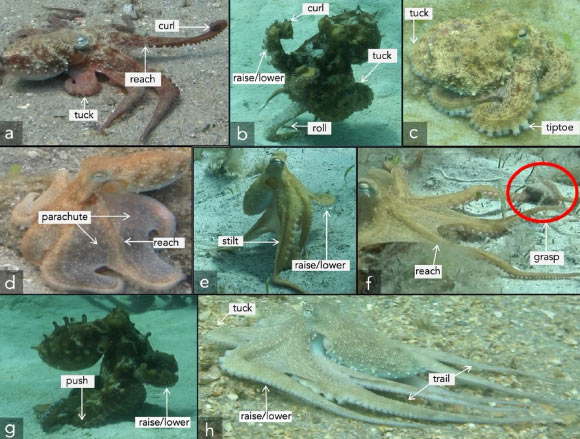New research provides a comprehensive look into how wild octopuses use their arms in natural habitats. By analyzing arm movements across diverse environments, this is the first study to relate arm movements to whole animal behaviors in complex, real-world settings. The findings reveal that every arm is capable of performing all action types; however, there was a clear pattern of arm partitioning: front arms mainly use movements to aid in exploration, while back arms use movements that primarily support movement. Additionally, the octopuses demonstrated remarkable flexibility — single arms were shown to perform multiple arm movements simultaneously and different arm movements were coordinated across several arms, showcasing their complex motor control.

Examples of 12 arm actions from wild octopuses; octopuses often used multiple arm actions on a single arm or multiple arms simultaneously. Image credit: Bennice et al., doi: 10.1038/s41598-025-10674-y.
Octopus arms are complex structures consisting of four separate muscle groups — transverse, longitudinal, oblique, and circular — around a central nerve.
These four muscle groups allow octopus arms to deform in a wide variety of ways to perform a range of actions used for various behaviors, from hunting and moving, to self-defense.
However, little is known about how wild octopuses use and coordinate their arms.
In the new study, Florida Atlantic University researcher Chelsea Bennice and colleagues analyzed 25 one-minute videos of wild octopuses, filmed between 2007 and 2015 in the Atlantic Ocean and Caribbean Sea.
The filmed octopuses were either common octopuses (Octopus vulgaris) or from the closely related species Octopus insularis or Octopus americanus.
The authors recorded which arms were used each time the octopuses performed one of fifteen distinct behaviors (such as crawling).
They also recorded what combination of twelve distinct arm actions (such as curling) took place during the behavior, and what combination of four distinct deformations (such as elongating) took place to perform each arm action.
The researchers found that all the octopuses could deform all eight arms in the four distinct ways, and could perform all of the actions with each arm.
They also found that arms on both side of the body are used equally, but that the front four arms are used significantly more often than the rear four arms (64% compared to 36%).
The front arms are more likely to be used to explore the surroundings, while the rear arms are more likely to be used to move the octopus around.
As a result, two actions are performed more often using the rear arms: roll, in which the arm moves underneath the octopus along the seafloor similar to a conveyor belt; and stilt, in which the arm is extended straight downwards to raise the body.
“Our results are some of the first to show that octopuses use specific limbs for specific tasks — behavior which is currently only well known in primates, rodents, and fish,” the scientists said.
“The findings could be used to improve robotic arms which mimic the functionality of octopus arms.”
The study was published this week in the journal Scientific Reports.
_____
C.O. Bennice et al. 2025. Octopus arm flexibility facilitates complex behaviors in diverse natural environments. Sci Rep 15, 31875; doi: 10.1038/s41598-025-10674-y







